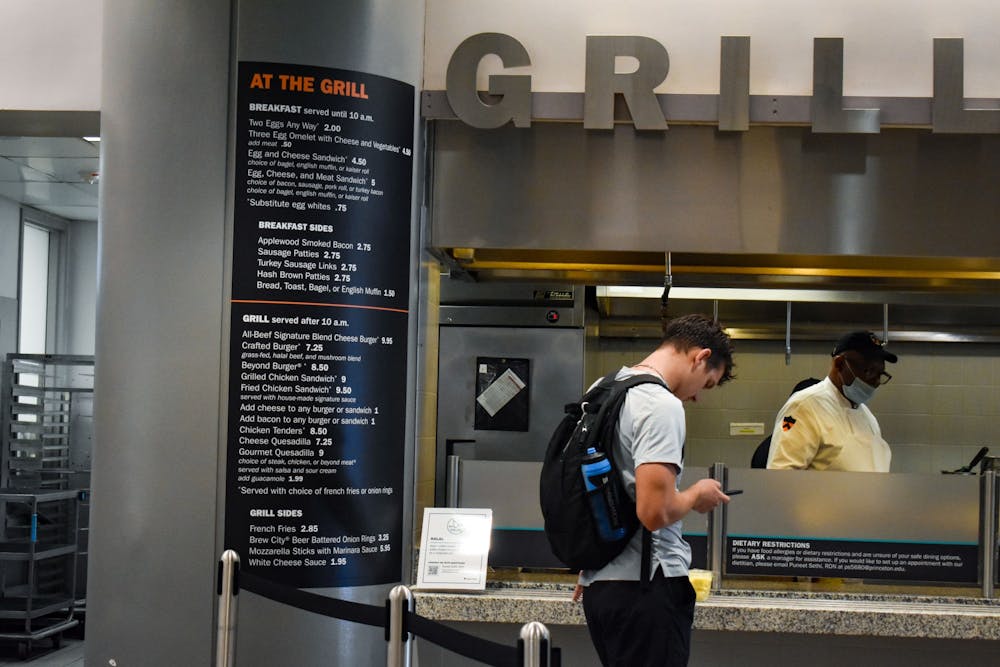Having been deprived of chicken quesadillas and mass-produced sushi since May, I was eager to return to Frist Campus Center for my first late meal of the year. It came as a surprise to me, then, to discover that food prices at the Food Gallery in Frist had increased from what they were last semester, with most entrées exceeding the Unlimited Dining Plan’s then-allotted $8 late lunch and dinner credit.
Although Princeton recently adjusted this credit to $9, the surge in pricing has nevertheless revealed a significant weakness of the current late meal pricing scheme: it fails to truly accommodate students who rely on its purported purpose. The University must restructure this system if it truly wishes to offer a viable meal alternative for its students: an entrée, side, and a drink should be the standardized late meal package, irrespective of price.
Over the past week, almost every peripheral conversation in Frist has been about the Food Gallery’s substantial increase in prices. Despite the increased late meal credit, many items remain inaccessible with the credit alone. For example, cheeseburgers and fried chicken sandwiches exceed the new $9 limit. Entrées at the other stations can be even more expensive, with some priced well beyond $10. The only item under the current limit at the new Asian food station, for example, is an appetizer portion of vegetable potstickers. This, of course, does not include the price of a drink.
According to the late meal page on Princeton University’s Campus Dining website, “Campus Dining recognizes that students may be unable to dine during regular dining hall hours. Therefore, students with meal plans are entitled to use their plan to purchase late lunches Monday to Friday and late dinner Monday to Thursday at the Food Gallery at Frist.” This not only explicitly acknowledges the too-common phenomenon of not being able to eat lunch or dinner due to commitments that may conflict with normal dining hall hours, but also highlights the need for providing students on meal plans with the meals they are entitled to, per their plans.
This semester, I will be unable to eat lunch in a dining hall Monday through Thursday because of class and scheduled commitments, so I will likely be eating late lunch four times a week. This is not a unique circumstance; countless students have classes, jobs, and obligations that will leave them in similar positions. Students must now either severely restrict their food options, or consistently pay out of pocket for lunch and/or dinner, effectively creating an unbalanced imposition on the students who may rely on late meal the most.
The newly introduced Dining Points system initially seems to remedy this problem: students on the unlimited meal plan receive $150 worth of dining points loaded onto their TigerCard at the beginning of every semester, which could be used to cover whatever the current late meal allowance doesn’t. However, this program was announced via email by the USG as “an opportunity for students to connect with each other and the town of Princeton without having to worry about paying out of pocket.” The Dining Points program was created for students to not have to choose between being able to enjoy and afford the occasional meal in Princeton or spend that money on a basic necessity like lunch. Using Dining Points to pay a remaining late meal balance defeats this purpose.
Another solution may be to raise the current late meal credit from its current $9, to a number that covers the price of every entrée — however, this is moving backwards. Instead, the University should abandon the credit system entirely so that every student on a meal plan may be guaranteed a late meal package of an entrée, side, and drink — at the very least — similar to how a dining swipe allows for unlimited access to the dining hall for that meal. The current structure is entirely dependent on the whims of inflation, costs, and gouging. Students on meal plans pay for meals, not discounted entrées.
Christofer Robles is a sophomore contributing columnist from Trenton, N.J. Christofer can be reached at cdrobles@princeton.edu or on Instagram @christofer_robles








